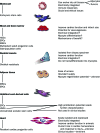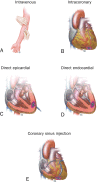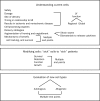Cardiac cell repair therapy: a clinical perspective
- PMID: 19797777
- PMCID: PMC2755807
- DOI: 10.4065/84.10.876
Cardiac cell repair therapy: a clinical perspective
Abstract
From bone marrow transplants 5 decades ago to the most recent stem cell-derived organ transplants, regenerative medicine is increasingly recognized as an emerging core component of modern practice. In cardiovascular medicine, innovation in stem cell biology has created curative solutions for the treatment of both ischemic and nonischemic cardiomyopathy. Multiple cell-based platforms have been developed, harnessing the regenerative potential of various natural and bioengineered sources. Clinical experience from the first 1000 patients (approximately) who have received stem cell therapy worldwide indicates a favorable safety profile with modest improvement in cardiac function and structural remodeling in the setting of acute myocardial infarction or chronic heart failure. Further investigation is required before early adoption and is ongoing. Broader application in practice will require continuous scientific advances to match each patient with the most effective reparative phenotype, while ensuring optimal cell delivery, dosing, and timing of intervention. An interdisciplinary effort across the scientific and clinical community within academia, biotechnology, and government will drive the successful realization of this next generation of therapeutic agents for the "broken" heart.
Figures







Comment in
-
Stem cell therapy and regenerative medicine.Mayo Clin Proc. 2009 Oct;84(10):859-61. doi: 10.4065/84.10.859. Mayo Clin Proc. 2009. PMID: 19797773 Free PMC article. No abstract available.
Similar articles
-
Stem cells: clinical trials results the end of the beginning or the beginning of the end?Cardiovasc Hematol Disord Drug Targets. 2010 Sep 1;10(3):186-201. doi: 10.2174/1871529x11006030186. Cardiovasc Hematol Disord Drug Targets. 2010. PMID: 20678060 Review.
-
Cardiac repair and the putative role of stem cells.J Mol Cell Cardiol. 2019 Mar;128:96-104. doi: 10.1016/j.yjmcc.2019.01.022. Epub 2019 Jan 28. J Mol Cell Cardiol. 2019. PMID: 30703353 Review.
-
Cardiac repair and regeneration: the Rubik's cube of cell therapy for heart disease.Dis Model Mech. 2009 Jul-Aug;2(7-8):344-58. doi: 10.1242/dmm.000240. Dis Model Mech. 2009. PMID: 19553696 Free PMC article. Review.
-
Cell-Based Therapy in Cardiac Regeneration: An Overview.Circ Res. 2018 Jul 6;123(2):132-137. doi: 10.1161/CIRCRESAHA.118.313484. Circ Res. 2018. PMID: 29976683 Review. No abstract available.
-
Therapeutic Application of Adult Stem Cells in the Heart.Methods Mol Biol. 2017;1553:249-264. doi: 10.1007/978-1-4939-6756-8_20. Methods Mol Biol. 2017. PMID: 28229422 Review.
Cited by
-
Selection of human induced pluripotent stem cells lines optimization of cardiomyocytes differentiation in an integrated suspension microcarrier bioreactor.Stem Cell Res Ther. 2020 Mar 13;11(1):118. doi: 10.1186/s13287-020-01618-6. Stem Cell Res Ther. 2020. PMID: 32183888 Free PMC article.
-
Systems-based technologies in profiling the stem cell molecular framework for cardioregenerative medicine.Stem Cell Rev Rep. 2015 Jun;11(3):501-10. doi: 10.1007/s12015-014-9557-5. Stem Cell Rev Rep. 2015. PMID: 25218144 Free PMC article. Review.
-
Functional multipotency of stem cells: a conceptual review of neurotrophic factor-based evidence and its role in translational research.Curr Neuropharmacol. 2011 Dec;9(4):574-85. doi: 10.2174/157015911798376299. Curr Neuropharmacol. 2011. PMID: 22654717 Free PMC article.
-
Stem cell applications in military medicine.Stem Cell Res Ther. 2011 Oct 19;2(5):40. doi: 10.1186/scrt81. Stem Cell Res Ther. 2011. PMID: 22011454 Free PMC article. Review.
-
Enabling stem cell therapies through synthetic stem cell-niche engineering.J Clin Invest. 2010 Jan;120(1):60-70. doi: 10.1172/JCI41158. J Clin Invest. 2010. PMID: 20051637 Free PMC article. Review.
References
-
- Sweet DJ. A new niche for a growing field [editorial]. Cell Stem Cell 2007;1(1):5-6 - PubMed
-
- Forrester JS, White AJ, Matsushita S, Chakravarty T, Makkar RR. New paradigms of myocardial regeneration post-infarction: tissue preservation, cell environment, and pluripotent cell sources. JACC Cardiovasc Interv. 2009;2(1):1-8 - PubMed
-
- Murry CE, Field LJ, Menasché P. Cell-based cardiac repair: reflections at the 10-year point. Circulation 2005;112(20):3174-3183 - PubMed
-
- Cooper R, Cutler J, Desvigne-Nickens P, et al. Trends and disparities in coronary heart disease, stroke, and other cardiovascular diseases in the United States: findings of the national conference on cardiovascular disease prevention. Circulation 2000;102(25):3137-3147 - PubMed
Publication types
MeSH terms
LinkOut - more resources
Full Text Sources
Medical
Molecular Biology Databases

